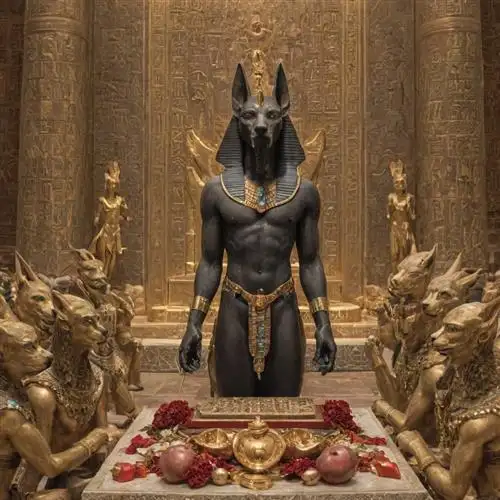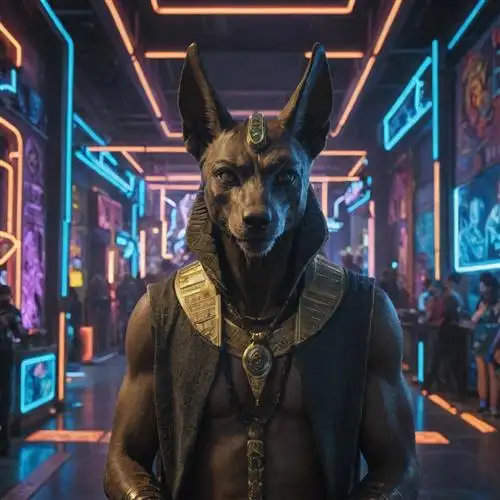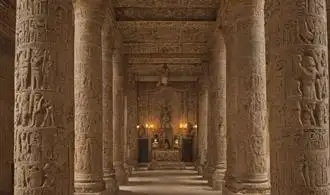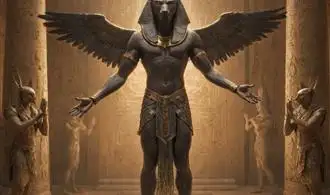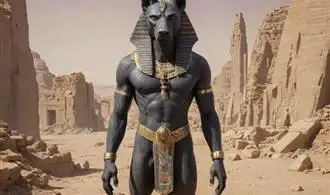
The Origins of the Anubis Deity
The origins of the Anubis deity can be traced back to ancient Egyptian mythology, where this jackal-headed figure played a significant role in the afterlife rituals and beliefs. As one of the oldest deities in the Egyptian pantheon, Anubis held a prominent position in the complex and intricate religious system of the ancient Nile civilization.
Anubis was believed to be the son of the gods Osiris and Nephthys, although some myths also suggest he was the son of Ra, the sun god. Regardless of his parentage, Anubis was revered as the god of embalming and the protector of the dead, responsible for guiding the deceased through the process of mummification and into the afterlife.
The jackal-headed form of Anubis was not merely a symbolic representation but held deep significance in the Egyptian worldview. Jackals were often seen near cemeteries, feeding on the remains of the dead, which led the Egyptians to associate these animals with the realm of the dead. Anubis, with his jackal-like features, was thus seen as the guardian of the necropolis and the protector of the deceased.
One of the key roles of Anubis was to preside over the weighing of the heart ceremony, a crucial ritual in the Egyptian afterlife beliefs. During this process, the heart of the deceased was weighed against the feather of Ma'at, the goddess of truth and justice. If the heart was found to be pure and free of sin, the individual was deemed worthy of entering the afterlife. Anubis played a vital role in this ceremony, ensuring the fairness and accuracy of the proceedings.
Anubis was also closely associated with the mummification process, as he was believed to have been the one who first embalmed the body of Osiris, the god of the underworld. This connection to the art of mummification solidified Anubis's status as a guardian of the dead and a critical figure in the Egyptian belief system.
The widespread veneration of Anubis is evident in the numerous temple complexes and shrines dedicated to the deity throughout ancient Egypt. These sacred sites served as hubs for the rituals and practices associated with the afterlife, further reinforcing the importance of Anubis in the religious and cultural landscape of the ancient Egyptians.
In addition to his role in the afterlife, Anubis was also believed to have the ability to protect the living from harm and to guide them through the challenging aspects of life. This dual nature, as both a guardian of the dead and a protector of the living, contributed to the enduring legacy of Anubis in the collective consciousness of the ancient Egyptian people.
The Significance of Anubis in Ancient Egyptian Mythology
Anubis, the jackal-headed deity, held a profound significance in the ancient Egyptian pantheon. As the god of the dead, embalming, and the afterlife, Anubis played a crucial role in the complex and intricate belief system of the ancient Egyptians. His importance can be understood through various aspects of his responsibilities and symbolism.
Anubis was responsible for the embalming and mummification process, ensuring the preservation of the deceased's physical body. This role was essential, as the Egyptians believed that the soul could only be reunited with the body in the afterlife. Anubis would oversee the entire mummification ritual, from the initial evisceration to the wrapping of the body, ensuring the process was carried out with the utmost care and precision.
In addition to his role in the embalming process, Anubis was also responsible for guiding the deceased through the afterlife. He would accompany the dead to the underworld, known as the "Hall of Two Truths," where the deceased's heart would be weighed against the feather of truth. This judgment determined whether the individual would be granted eternal life in the afterlife or be condemned to eternal damnation.
The jackal-headed figure of Anubis was a deliberate choice, as jackals were often found near ancient Egyptian cemeteries, scavenging for food. This association with the dead and the underworld cemented Anubis' role as the guardian of the necropolis and the protector of the deceased.
Anubis was also closely connected to the mummification process, as the jackal was believed to have the ability to detect the scent of the dead. This connection to the act of embalming and the preparation of the body for the afterlife made Anubis a crucial figure in the Egyptian conception of the afterlife and the journey of the soul.
The significance of Anubis extended beyond his role in the afterlife. He was also associated with the process of rebirth and regeneration, as the jackal was seen as a symbol of new life emerging from the dead. This connection to the cycle of life and death further solidified Anubis' place as a central figure in the ancient Egyptian belief system.
The Iconography and Symbolism of Anubis
Anubis, the ancient Egyptian deity associated with mummification and the afterlife, is a fascinating figure whose iconography and symbolism hold deep significance. As one of the most prominent deities in the Egyptian pantheon, Anubis' visual representation and the symbols associated with him provide valuable insights into his role and the beliefs surrounding him.
The most recognizable feature of Anubis is his jackal-headed form. This distinctive appearance is believed to have several layers of meaning. The jackal, a scavenger animal often found near ancient Egyptian necropolises, was chosen to represent Anubis due to its association with the dead and the underworld. The jackal-headed form may also allude to Anubis' role as a guide and protector of the deceased, leading them through the perils of the afterlife.
Another key aspect of Anubis' iconography is the color of his skin, which is typically depicted as black. This color choice is not arbitrary but rather carries profound symbolic meaning. The black color is thought to represent the fertile black soil of the Nile Valley, which was essential for agricultural prosperity and the cycle of life and death. Additionally, the black color may also symbolize the color of mummified flesh, further emphasizing Anubis' connection to the process of mummification and the preservation of the dead.
The staff or scepter often seen in Anubis' hands is another significant symbol associated with the deity. This staff, known as a was-scepter, is believed to represent authority, power, and the ability to control the forces of the underworld. The was-scepter may also symbolize Anubis' role as a guide and protector, leading the deceased through the challenges of the afterlife.
Interestingly, Anubis is sometimes depicted with a set of scales, which is thought to represent his role in the judgment of the dead. In the weighing of the heart ceremony, Anubis would oversee the process of weighing the deceased's heart against the feather of truth, determining their worthiness to proceed to the afterlife.
The funerary items and objects associated with Anubis also hold symbolic significance. For instance, the canopic jars used to store the internal organs of the deceased during mummification were often adorned with the jackal-headed image of Anubis, further emphasizing his role in the afterlife and the preservation of the body.
The Rituals and Practices Associated with Anubis
Anubis, the jackal-headed deity, held a central role in ancient Egyptian religious practices and ceremonies. As the god associated with embalming, funerary rites, and the afterlife, the rituals and customs surrounding Anubis were deeply embedded within the fabric of Egyptian culture.
One of the most significant rituals involving Anubis was the mummification process. Anubis was believed to oversee the embalming of the deceased, ensuring the proper preservation of the body for the journey to the afterlife. The embalmer, who played a crucial role in this process, would invoke the name of Anubis, seeking the deity's guidance and protection throughout the complex mummification procedure.
Funerary rites and the interment of the dead were also closely tied to Anubis. The jackal-headed god was responsible for leading the deceased through the underworld and guiding the soul to the final judgment before Osiris, the god of the dead. Rituals such as the "Opening of the Mouth" ceremony, where the deceased's mouth was "opened" to allow the spirit to speak and breathe, were performed with Anubis as the primary officiant.
Moreover, Anubis played a vital role in the Book of the Dead, a collection of spells and incantations believed to aid the deceased in their journey to the afterlife. These spells often invoked the name of Anubis, seeking the god's protection and guidance during the perilous passage through the underworld.
Worshippers of Anubis would participate in various rituals and practices to honor the deity and ensure their own safe passage to the afterlife. These could include offerings of food, incense, and other symbolic items placed in the tombs or temples dedicated to Anubis. Priests and devotees may have also engaged in rituals to commune with Anubis, seeking the god's wisdom and blessings.
The Influence of Anubis on Contemporary Culture
Anubis, the ancient Egyptian deity associated with mummification and the afterlife, has maintained a significant presence in contemporary culture. This revered figure, often depicted with the head of a jackal, continues to captivate the imagination of artists, writers, and the general public alike.
One of the most prominent ways Anubis has influenced contemporary culture is through its widespread representation in popular media. From blockbuster films like "The Mummy" to television shows like "Stargate SG-1," Anubis has become a recognizable icon, often serving as a symbol of the mysterious and enigmatic aspects of ancient Egyptian mythology. These portrayals have helped to keep the legacy of Anubis alive, introducing this captivating deity to new generations of audiences.
In the realm of art, Anubis has inspired countless creative works. Painters, sculptors, and illustrators have reimagined the deity, reinterpreting its iconography and symbolism to produce visually striking pieces that explore the themes of death, transformation, and the afterlife. These artistic expressions have not only preserved the cultural significance of Anubis but have also contributed to a deeper understanding and appreciation of this powerful figure.
Beyond the realm of entertainment and the arts, Anubis has also found a place in contemporary spiritual and esoteric practices. Some modern Pagan and Wiccan traditions have incorporated Anubis into their rituals and belief systems, recognizing the deity's role as a guide and protector of the dead. This resurgence of interest in Anubis has led to the creation of various occult and metaphysical resources, further solidifying the deity's place in the collective consciousness of those seeking to connect with ancient Egyptian spirituality.


